Joel Lane Museum House director Lanie Hubbard shows how a group of enslaved people from late 18th-century North Carolina was recently memorialized.
###
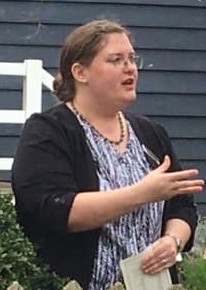 Relevant History welcomes Lanie Hubbard, director of the Joel Lane Museum House (JLMH) in Raleigh, North Carolina. A native of Arizona, Lanie’s background for the position is unorthodox. An MA in literature honed her research and storytelling skills; and she spent four New Mexico summers in historic costume, teaching Boy Scouts to blacksmith and apply cattle brands to their hiking boots, while keeping the kids from getting themselves eaten by bears. Blacksmithing and boot-ruining taught Lanie to love sharing history, while camp oversight and bear-disappointment prepared her for management. After joining JLMH as a part-time docent in 2014, she became director in 2017. To learn more, follow JLMH on Facebook.
Relevant History welcomes Lanie Hubbard, director of the Joel Lane Museum House (JLMH) in Raleigh, North Carolina. A native of Arizona, Lanie’s background for the position is unorthodox. An MA in literature honed her research and storytelling skills; and she spent four New Mexico summers in historic costume, teaching Boy Scouts to blacksmith and apply cattle brands to their hiking boots, while keeping the kids from getting themselves eaten by bears. Blacksmithing and boot-ruining taught Lanie to love sharing history, while camp oversight and bear-disappointment prepared her for management. After joining JLMH as a part-time docent in 2014, she became director in 2017. To learn more, follow JLMH on Facebook.
*****
On Sunday 16 February 2020, dozens of members of the Raleigh community gathered at the JLMH to dedicate a new memorial to forty-three men, women, and children enslaved by Joel Lane and his family. We talked about the history, spoke the names, and prayed. Likely descendants of the enslaved lifted the cloth, revealing the new monument. We sang “Amazing Grace.” It was a profound experience. (Check out the news story posted a few days before the ceremony.)
This site was the seat of a large plantation founded in 1769. We speak of Joel Lane as a local founding father. If we are to fully explore the history of this place and Lane’s role in founding Wake County, Raleigh, and America, we must discuss human bondage.
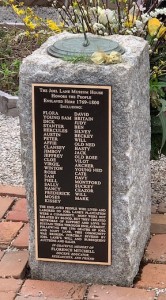 The memorial, cast in bronze and mounted to the granite pillar supporting the sundial in our Herb Garden, bears the name of each enslaved person our researchers have identified. For the first time, permanently installed on the grounds of Joel Lane’s former plantation, stands a physical tribute to those whose lives and labor were twisted into the warp and weave of life in this place, whose hands laid the literal foundations. The new plaque reflects a history that is factually inseparable from the other stories of our beginnings.
The memorial, cast in bronze and mounted to the granite pillar supporting the sundial in our Herb Garden, bears the name of each enslaved person our researchers have identified. For the first time, permanently installed on the grounds of Joel Lane’s former plantation, stands a physical tribute to those whose lives and labor were twisted into the warp and weave of life in this place, whose hands laid the literal foundations. The new plaque reflects a history that is factually inseparable from the other stories of our beginnings.
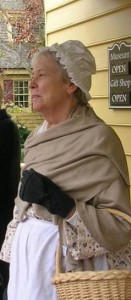 It also stands in memory of Florence Mitchell, longtime docent and education chair. She made a mission of researching the people enslaved by Joel Lane and added greatly to our knowledge. Florence left a generous 2018 bequest to the museum. This permanent memorial to the enslaved, made possible by that gift, honors her work and continues it.
It also stands in memory of Florence Mitchell, longtime docent and education chair. She made a mission of researching the people enslaved by Joel Lane and added greatly to our knowledge. Florence left a generous 2018 bequest to the museum. This permanent memorial to the enslaved, made possible by that gift, honors her work and continues it.
As we began the project, space was limited. JLMH stands on about a third of an acre—land already occupied by four structures, a formal garden, and an herb garden. It was in the herb garden that we found our solution: a sundial that never quite fit in. We would turn a distraction into a teaching tool. We seem to do that a lot.
Embracing anachronism
Lately, I’ve been teaching every third grader who crosses our threshold the word anachronism. It’s our docents’ delightful job to dress up in colonial clothing and physically guide the children into the foreign world of the eighteenth century, while gently reminding them not to touch the teacups. It’s every eight-year-old’s job, contractually, to point out a smoke detector and demand, “okay, so what’s that?”—then use the distraction to reach for the forbidden teacups.
Children use the tools we give them. When I give them the word anachronism, they can contextualize not only the smoke detector, but my strange period costume. In their electrical-digital world, my apron and cap set me outside of their time—but in my world, they’re the visitors, with a tourist’s eagerness to explore. I introduce myself as anachronism, then lead them to a place where they become anachronism. That smoke detector, then, isn’t a glitch they can exploit to confuse me—it’s simply an anachronism, much less interesting than the teacup I’m showing them. This strategy lets me teach them not only the local history but a wider, conceptual notion of History. Anachronism gives us context to move past the little modern distractions to compare and contrast eras, discuss how people solved problems in the past, and find, through difference, the similarities people share across time.
The sundial
It all works until the tour reaches the sundial, which manages to disrupt tours like—well, like clockwork. By the time a class makes it to the herb garden, their docent has already shepherded them through myriad more obvious distractions. The nearby train whistle. A chaperone’s cell phone ringer. That neighbor with a big yellow hat and a bushy beard who rides a bicycle lifted like a monster truck. A squirrel.
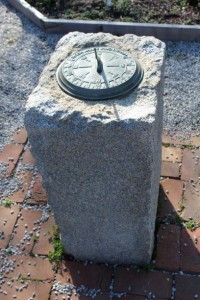 The sundial is a circle of green-patinaed bronze, mounted on a grey, rough-hewn granite block, still marked from the quarry. Green on grey stone, in a garden of green herbs and grey gravel. It’s the sort of ornament one expects in a historical garden. Adults tend not to notice it.
The sundial is a circle of green-patinaed bronze, mounted on a grey, rough-hewn granite block, still marked from the quarry. Green on grey stone, in a garden of green herbs and grey gravel. It’s the sort of ornament one expects in a historical garden. Adults tend not to notice it.
It’s all third-graders can see. Children flock to the sundial. “What is that?” “Is everyone late when it rains?” “What about Daylight Savings?” “Isn’t it better to have a clock indoors?” “How do they wake up if it doesn’t have an alarm?”
This is supposed to be the part of the tour where we talk about herbs. Yarrow to stop bleeding. Tansy to repel flies and as yellow dye. Rosemary for remembrance. Lamb’s ear as top-shelf colonial-era toilet paper. Medicines, flavors, chemicals, symbols; see and touch and smell. The sundial, in comparison, doesn’t offer much. It’s a technology that had existed millennia before Joel Lane’s time, but an object no more important to everyday life in the eighteenth century than to the twenty-first. (Clocks existed!) It is doubly anachronistic—unfamiliar to the children, but irrelevant to the tour.
Thus a longstanding problem became our solution, centered in a place of peace and honor, surrounded by fruits of the sorts of labor the enslaved were made to perform. We mounted the plaque on the northern face. The homes of the enslaved were probably to the north. North for hope, for freedom. North, toward an end to slavery. The once-distracting sundial will now begin a new conversation, about the most troubling anachronism of all: slavery.
Slavery has been integral to JLMH interpretation since before my time as director. It’s a troubling subject that rightfully pulls joy from docent and guests alike—it makes people sad and angry. It can be difficult to explain to children. They innately understand the unfairness and wrongness of it, but not how people could justify doing such a thing. They’ve learned of Joel Lane as a founding father, but can someone whose accomplishments relied on enslaved labor be a great man? Can he be good? These are the questions a docent doesn’t answer. We just help kids ask them. The new memorial honors the enslaved and supports this work.
*****
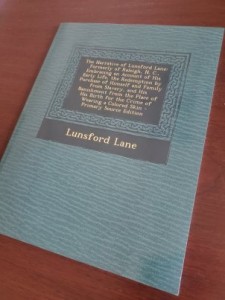 A big thanks to Lanie Hubbard! She’ll give away a copy of The Narrative of Lunsford Lane, an autobiography of the son of one of Joel Lane’s slaves; plus a set of four tour tickets to the Joel Lane Museum House (no expiration date), to someone who contributes a comment on my blog this week. I’ll choose the winner from among those who comment by Friday at 6 p.m. ET. Delivery is available worldwide.
A big thanks to Lanie Hubbard! She’ll give away a copy of The Narrative of Lunsford Lane, an autobiography of the son of one of Joel Lane’s slaves; plus a set of four tour tickets to the Joel Lane Museum House (no expiration date), to someone who contributes a comment on my blog this week. I’ll choose the winner from among those who comment by Friday at 6 p.m. ET. Delivery is available worldwide.
**********
Did you like what you read? Learn about downloads, discounts, and special offers from Relevant History authors and Suzanne Adair. Join Suzanne Adair’s Patreon, and subscribe to her free newsletter.

Just a quick hi to let you know I stopped by and read the article!
What a beautifully written article! Thank you both for taking such care in the writing.
Thank you, Wendy! It’s such a pleasure to be able to reflect on these things and share the behind-the-scenes thinking.
A lovely and powerful piece. You don’t need to enter me in the drawing, but I wanted to say thank you for sharing.
Thank you for reading!
This piece gives me hope that similar memorials will be created at historic places around the country.One of my ancestors owned a plantation in West Virginia, Green Bottom, now the home of the Jenkins Plantation Museum.I plan to share this information with the folks doing renovations at Green Bottom so that we may also honor the enslaved who labored there.Thank you for your wisdom as you work with your young visitors!
Thank you, Marion!
If it helps, I’m happy to chat with you, or Jenkins team, about our experiences in bringing this project to fruition if it’s helpful, and about our philosophy as we teach about troubling history.
If you’d like to reach out, a note through our website will come to me directly: https://www.joellane.org/joellane/contact.
Great blog guest this week. I enjoy going to the Joel Lane house and gardens. The blog gave me a new persecution from a child’s view. Thanks for sharing it.
Thank you, Karen!
We’re so excited for this new addition to the gardens. I hope to see you soon!
Really good article. Thank you. Wouldn’t it be wonderful if this idea took off.
I will be forwarding this to my son-in-law to read. He is a history teacher.
Thank you for sharing!